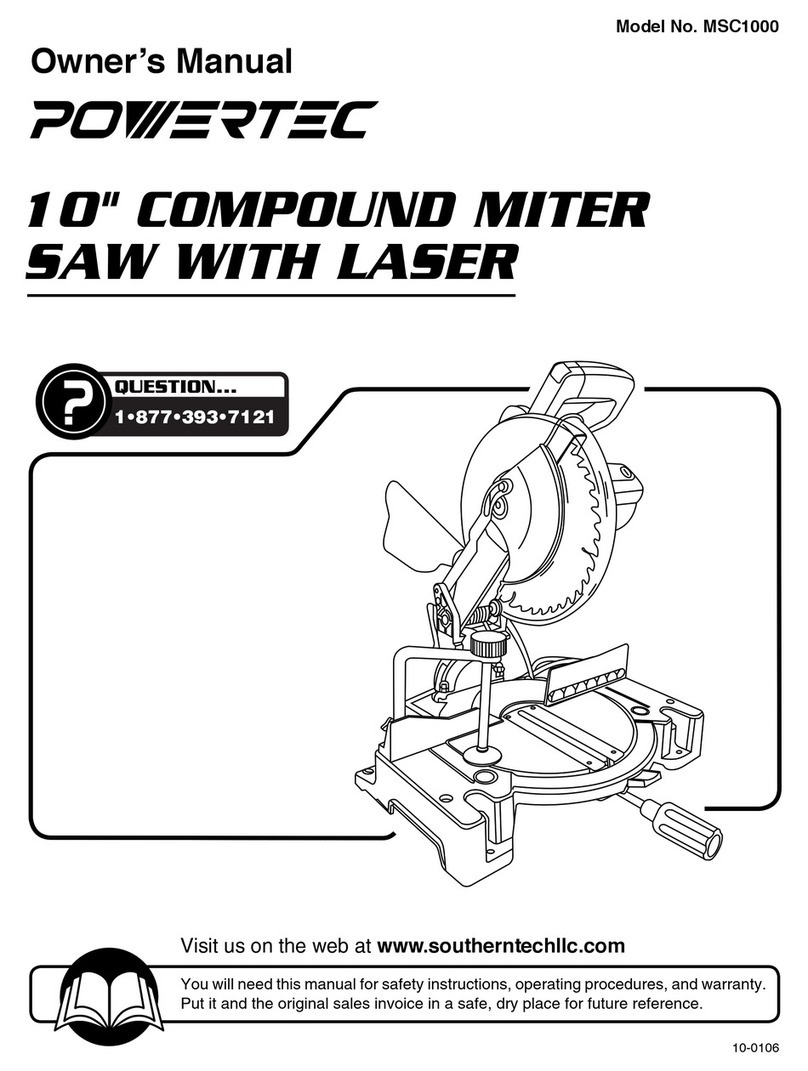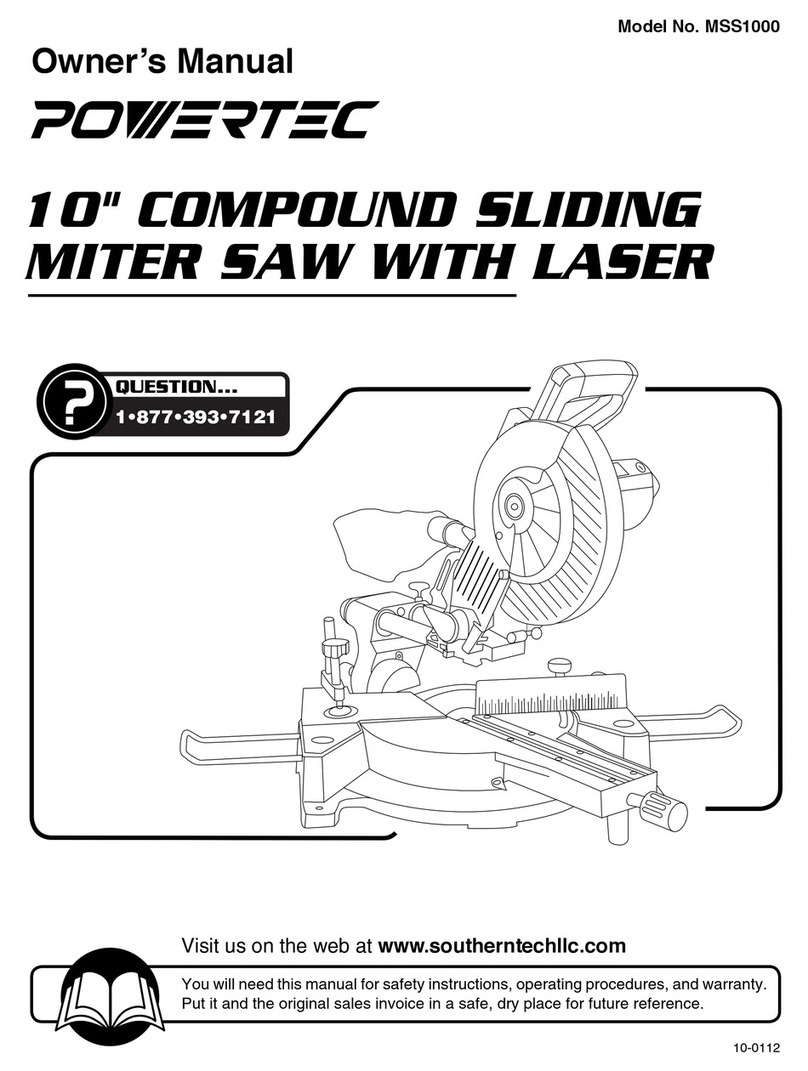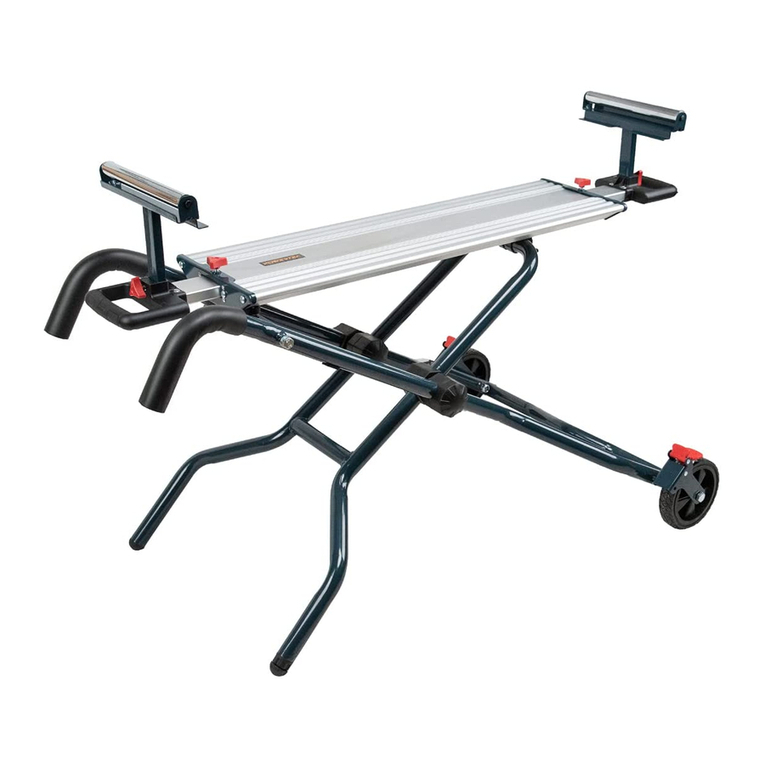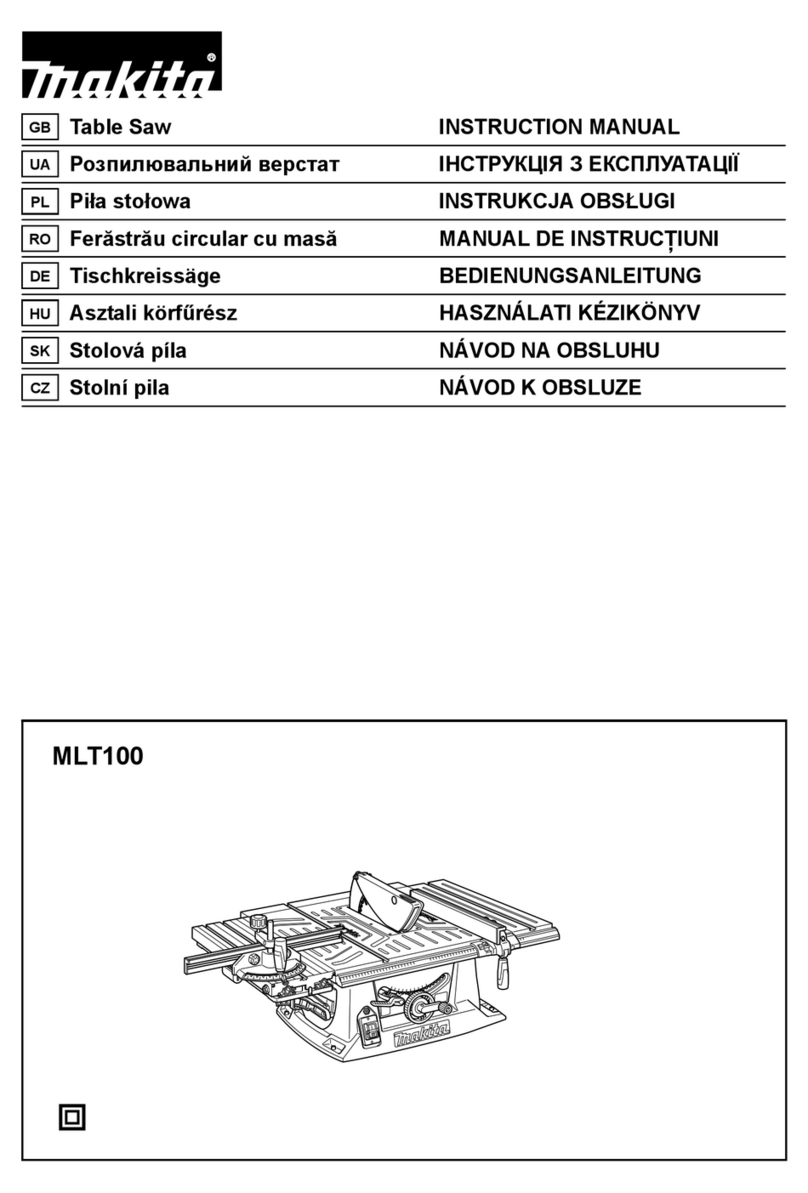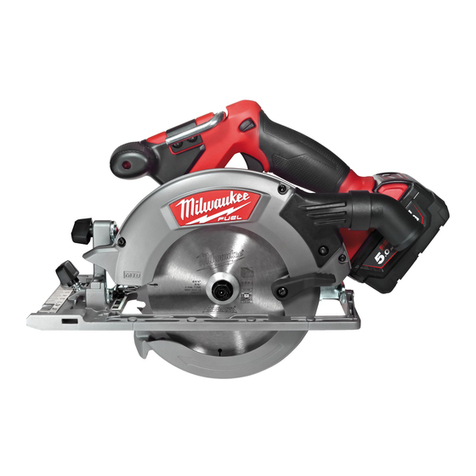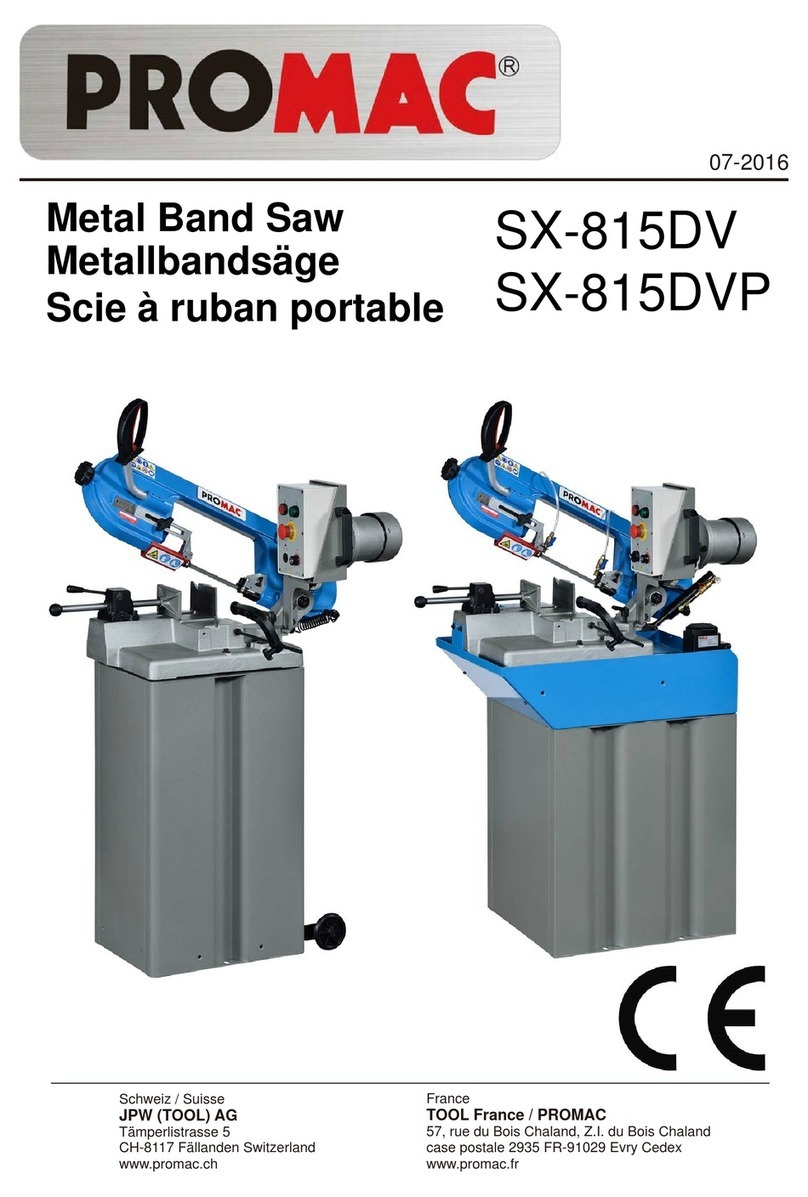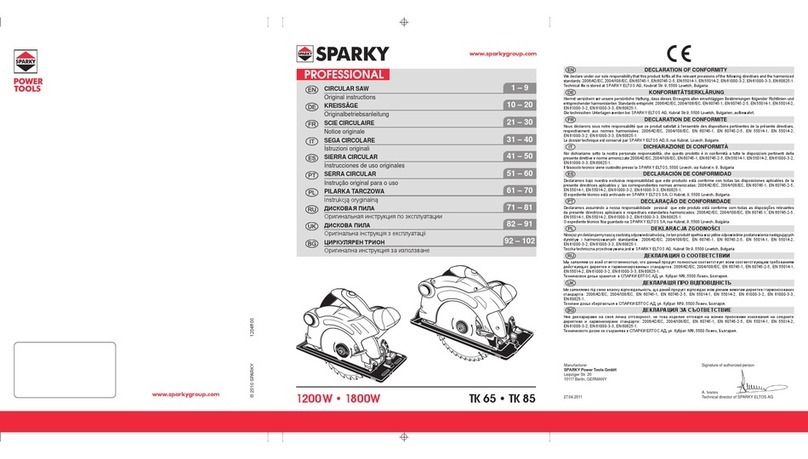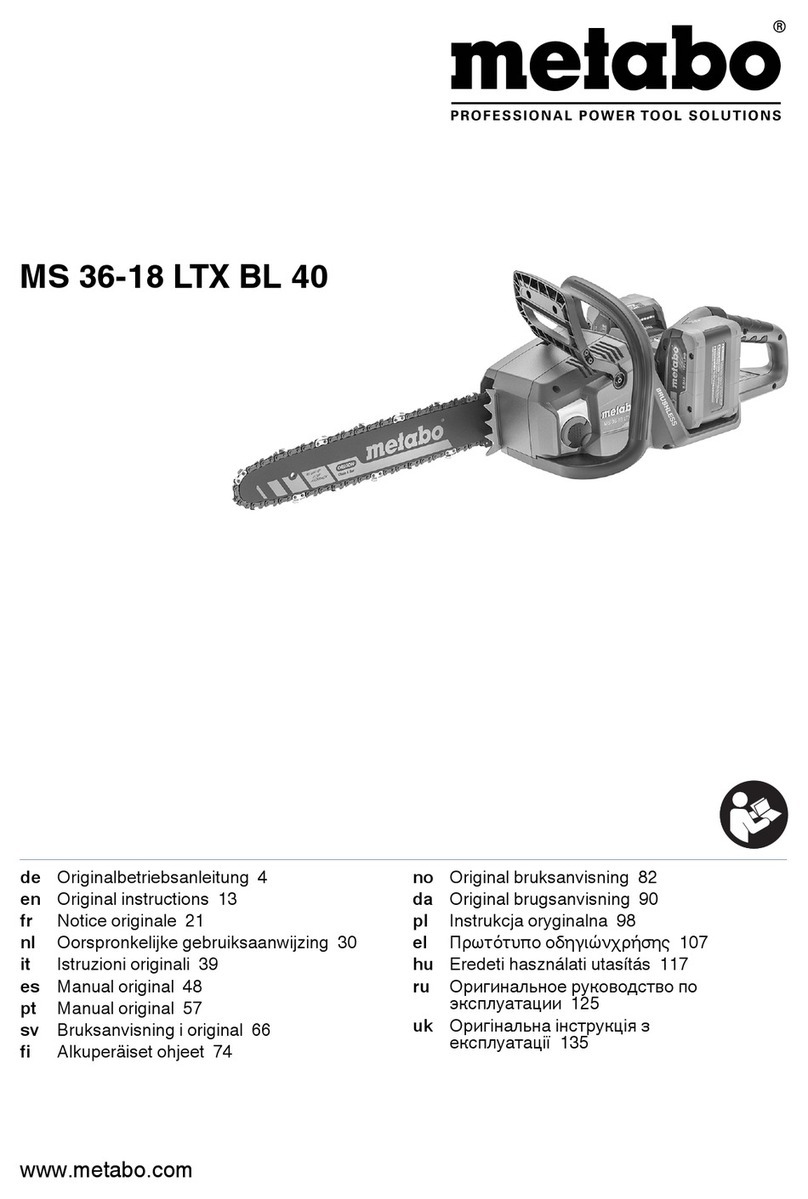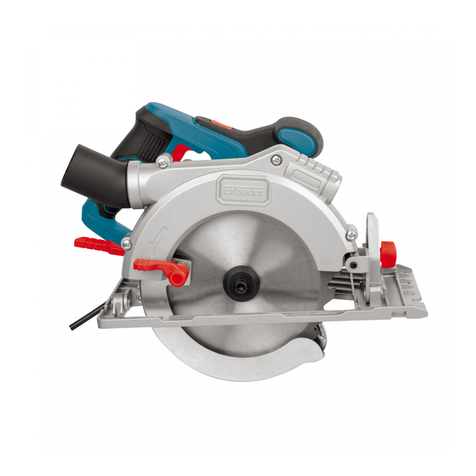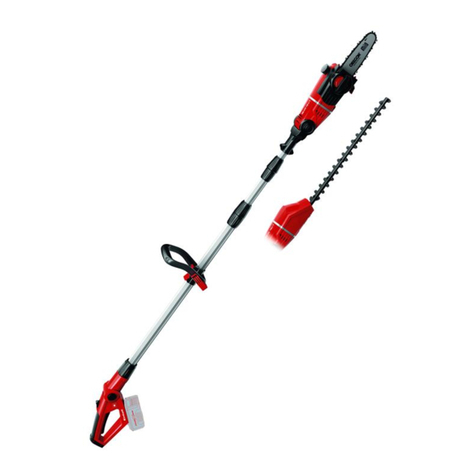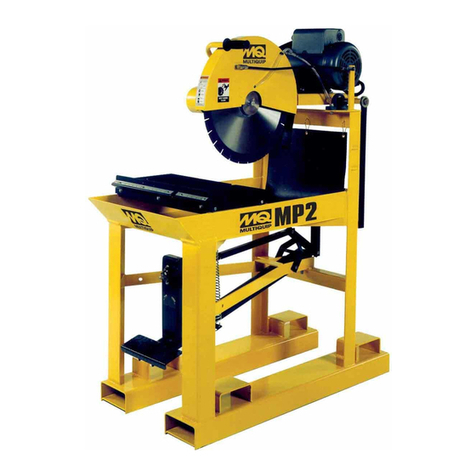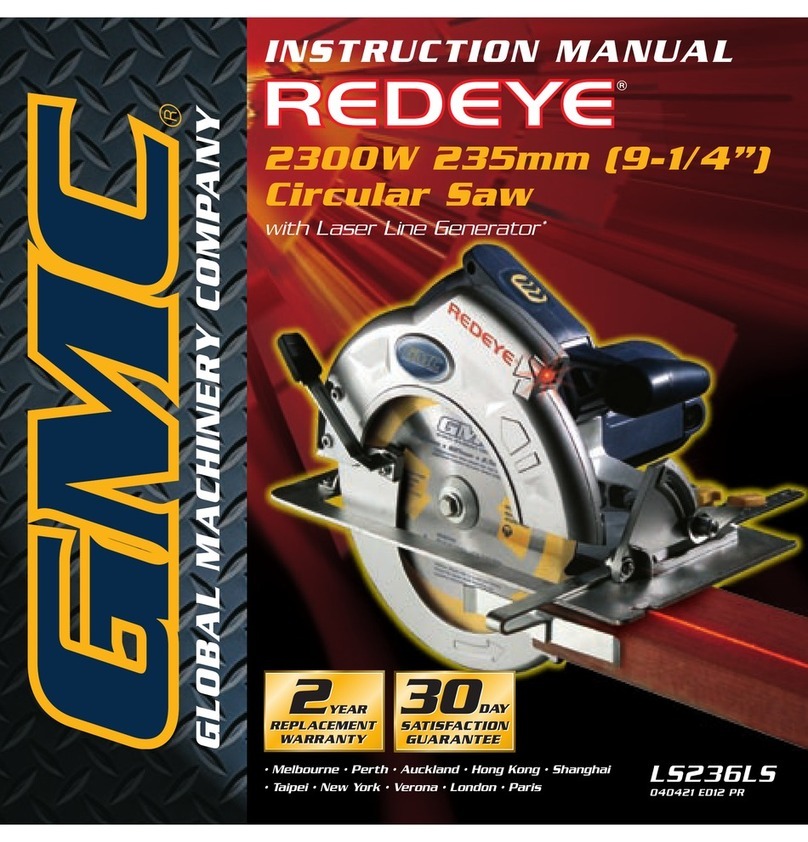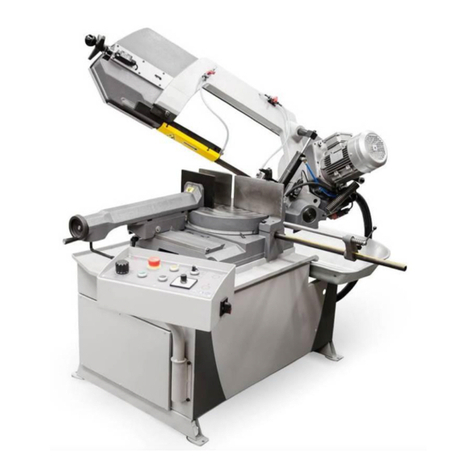Power Tec R2103 User manual

PORTABLE BAND SAW
Model No:R2103

01
1
ATension handle
BExternal carbon brush
CAuxiliary Handle
D Motor housing
E Speed dial
FOn/Off switch
G Guide bar
HBlade
I Screw
JGuide Bearing
K
L
LED on/off
LED light
A
B
C
DE
F
H
L
G
I
J
K

02
H
G
I
J

1100W10A
TECHNICAL SPECIFICATIONS
Model Number
Voltage
Power
R2103
Protection class
44-7/8''(L)x1/2''(W)x0.025''(Thick)
1141(L)x13mm(W)x0.65mm(Thick)
0-435SFPM 0.7-2.4m/s
127x127mm
WARNING! Read all safety warnings and all instructions. Failure to follow the
warnings and instructions may result in electric shock, fire and/or serious injury.
Save all warnings and instructions for future reference. The term “power tool” in the
warnings refers to your mainsoperated (corded) power tool or battery-operated
(cordless) power tool.
SAFETY
GENERAL SAFETY INSTRUCTIONS
1.WORK AREA SAFETY
> Keep work area clean and well lit. Cluttered or dark areas invite accidents.
> Do not operate power tools in explosive atmospheres, such as in the presence of
flammable liquids, gases or dust. Power tools create sparks which may ignite the
dust or fumes.
> Keep children and bystanders away while operating a power tool. Distractions can
cause you to lose control.
2.ELECTRICAL SAFETY
> Power tool plugs must match the outlet. Never modify the plug in any way. Do not
use any adapter plugs with earthed (grounded) power tools.Unmodified plugs and
matching outlets will reduce risk of electric shock.
> Avoid body contact with earthed or grounded surfaces such as pipes, radiators,
ranges and refrigerators. There is an increased risk of electric shock if your body is
earthed or grounded.
> Do not expose power tools to rain or wet conditions.Water entering a power tool
will increase the risk of electric shock.
> Do not abuse the co rd. Never use the cord for carrying, pulling or unplugging the
power tool. Keep cord away from heat, oil, sharp edges or moving parts. Damaged
or entangled cords increase the risk of electric shock.
> When operating a power tool outdoors, use an extension cord suitable for outdoor
use. Use of a cord suitable for outdoor use reduces the risk of electric shock.
03
Blade FPM
Blade Dimensions
Cutting Capacity
220-240V~,50Hz120V~,60Hz
5''

3.PERSONAL SAFETY
> Stay alert, watch what you are doing and use common sense when operating a
power tool. Do not use a power tool while you are tired or under the influence of
drugs, alcohol or medication. A moment of inattention while operating power
tools may result in serious personal injury.
> Use personal protective equipment. Always wear eye protection. Protective
equipment such as dust mask, non-skid safety shoes, hard hat, or hearing
protection used for appropriate conditions will reduce personal injuries.
> Prevent unintentional starting. Ensure the switch is in the off-position before
connecting to power source and/or battery pack, picking up or carrying the tool.
Carrying power tools with your finger on the switch or energising power tools that
have the switch on invites accidents.
> Remove any adjusting key or wrench before turning the power tool on. A wrench
or a key left attached to a rotating part of the power tool may result in personal
injury.
> Do not overreach. Keep proper footing and balance at all times. This enables
better control of the power tool in unexpected situations.
> Dress properly. Do not wear loose clothing or jewelry. Keep your hair, clothing
and gloves away from moving parts. Loose clothes, jewelry or long hair can be
caught in moving parts.
> If devices are provided for the connection of dust extraction and collection
facilities, ensure these are connected and properly used. Use of dust collection
can reduce dust-related hazards.
4. POWER TOOL USE AND CARE
> Do not force the power tool. Use the correct power tool for your application. The
correct power tool will do the job better and safer at the rate for which it was
designed.
> Do not use the power tool if the switch does not turn it on and off. Any power tool
that cannot be controlled with the switch is dangerous and must be repaired.
> Disconnect the plug from the power source and/or the battery pack from the power
tool before making any adjustments, changing accessories, or storing power tools.
Such preventive safety measures reduce the risk of starting the power tool
accidentally.
> Store idle power tools out of the reach of children and do not allow persons
unfamiliar with the power tool or these instructions to operate the power tool.
Power tools are dangerous in the hands of untrained users.
04
> If operating a power tool in a damp location is unavoidable, use an earth leakage
circuit breaker. Use of an earth leakage circuit breaker reduces the risk of electric
shock.

> Maintain power tools. Check for misalignment or binding of moving parts,
breakage of parts and any other condition that may affect the power tool's
operation. If damaged, have the power tool repaired before use. Many accidents
are caused by poorly maintained power tools.
> Keep cutting tools sharp and clean. Properly maintained cutting tools with sharp
cutting edges are less likely to bind and are easier to control.
> Use the power tool, accessories and tool bits etc., in accordance with these
instructions, taking into account the working conditions and the work to be
performed. Use of the power tool for operations different from those intended
could result in a hazardous situation.
5.SERVICE
> Have your power tool serviced by a qualified repair person using only identical
replacement parts. This will ensure that the safety of the power tool is maintained.
05
SAFETY INSTRUCTIONS FOR PORTABLE BAND SAW
> Hold power tool by insulated gripping surfaces, when performing an operation
where the cutting accessory may contact hidden wiring or its own cord. Cutting
accessories contacting a “live” wire may make exposed metal parts of the power
tool “live” and could give the operator an electric shock.
> Never leave the Bandsaw unattended while it is running. Do not put the Bandsaw
down until the blade comes to a complete stop.
> Before each use, make sure the Tension Handle is in the tightened position
(making the blade taut).
> Cutting Material. Make sure cutting material is securely fastened down before
operating the Bandsaw. Work slowly and carefully when cutting corners, sharp
edges, ragged welds, etc., to avoid snagging.
> Cutting material and the motor housing can get very hot during operation. Stop
work until unit cools down to safe temperature. Spray a coolant or water onto the
blade.
> Maintain labels and nameplates on the tool. These carry important safety
information. If unreadable or missing, contact Harbor Freight Tools for a
replacement.
> Avoid unintentional starting. Prepare to begin work before turning on the tool.
> Do not lay the tool down until it has come to a complete stop. Moving parts can
grab the surface and pull the tool out of your control.
> When using a handheld power tool, maintain a firm grip on the tool with both hands
to resist starting torque.
> Do not leave the tool unattended when it is plugged into an electrical outlet. Turn
off the tool, and unplug it from its electrical outlet before leaving.
> This product is not a toy. Keep it out of reach of children.

06
> People with pacemakers should consult their physician(s) before use.
Electromagnetic fields in close proximity to heart pacemaker could cause
pacemaker interference or pacemaker failure. In addition, people with
pacemakers should: Avoid operating alone. Do not use with power switch locked
on. Properly maintain and inspect to avoid electrical shock. Any power cord must
be properly grounded. Ground Fault Circuit Interrupter (GFCI) should also be
implemented – it prevents sustained electrical shock.
> WARNING: Some dust created by power sanding, sawing, grinding, drilling, and
other construction activities, contains chemicals known to the State of California
to cause cancer and birth defects or other reproductive harm. Some examples of
these chemicals are: Lead from lead-based paints Crystalline silica from bricks
and cement or other masonry products Arsenic and chromium from chemically
treated lumberYour risk from these exposures varies, depending on how often
you do this type of work. To reduce your exposure to these chemicals: work in a
well ventilated area, and work with approved safety equipment, such as those
dust masks that are specially designed to filter out microscopic particles.
(California Health & Safety Code § 25249.5, et seq.)
> WARNING: The cord of this product contains lead and/or di (2-ethylhexyl)
phthalate (DEHP), chemicals known to the State of California to cause cancer,
and birth defects or other reproductive harm. Wash hands after handling.
(California Health & Safety Code § 25249.5, et seq.)
> The warnings, precautions, and instructions discussed in this instruction manual
cannot cover all possible conditions and situations that may occur. It must be
understood by the operator that common sense and caution are factors which
cannot be built into this product, but must be supplied by the operator.
Vibration Safety
This tool vibrates during use. Repeated or long-term exposure to vibration may
cause temporary or permanent physical injury, particularly to the hands, arms and
shoulders. To reduce the risk of vibration-related injury:
> Anyone using vibrating tools regularly or for an extended period should first be
examined by a doctor and then have regular medical check-ups to ensure medical
problems are not being caused or worsened from use. Pregnant women or people
who have impaired blood circulation to the hand, past hand injuries, nervous
system disorders, diabetes, or Raynaud's Disease should not use this tool. If you
feel any symptoms related to vibration (such as tingling, numbness, and white or
blue fingers), seek medical advice as soon as possible.
> Do not smoke during use. Nicotine reduces the blood supply to the hands and
fingers, increasing the risk of vibration-related injury.

07
GENERAL
•This tool should not be used by people under the age of 16 years
•This tool is not intended for use by persons (including children) with reduced
physical, sensory or mental capabilities, or lack of experience and knowledge,
unless they have been given supervision or instruction concerning use of the tool
by a person responsible for their safety
•Ensure that children do not play with the tool
•Always disconnect plug from power source before making any adjustment
or changing any accessory
>Wear suitable gloves to reduce the vibration effects on the user.
>Use tools with the lowest vibration when there is a choice.
>Include vibration-free periods each day of work.
>Grip tool as lightly as possible (while still keeping safe control of it). Let the tool do
the work.
>To reduce vibration, maintain the tool as explained in this manual. If any abnormal
vibration occurs, stop use immediately.

OUTDOOR USE
• Connect the tool via a fault current (FI) circuit breaker with a triggering current of
30 mA maximum
BEFORE USE
• Before using the tool for the first time, it is recommended to receive practical
information
• Always check that the supply voltage is the same as the voltage indicated on the
nameplate of the tool (tools with a rating of 230V or 240V can also be connected to
a 220V supply)
•Use suitable detectors to find hidden utility lines or call the local utility
company for assistance(contact with electric lines can lead to fire or electrical
shock; damaging a gas line can result in an explosion; penetrating a water pipe
will cause property damage or an electrical shock)
•Do not work materials containing asbestos (asbestos is considered carcinogenic)
• Dust from material such as paint containing lead, some wood species, minerals
and metal may be harmful (contact with or inhalation of the dust may cause allergic
reactions and/or respiratory diseases to the operator or bystanders); wear a dust
mask and work with a dust extraction device when connectable
• Certain kinds of dust are classified as carcinogenic (such as oak and beech dust)
especially in conjunction with additives for wood conditioning; wear a dust mask
and work with a dust extraction device when connectable
• Follow the dust-related national requirements for the materials you want to work with
• Do not clamp the tool in a vice
• Use completely unrolled and safe extension cords with a capacity of 16 Amps
(U.K. 13 Amps)
AFTER USE
• After switching off the tool, never stop the rotation of the accessory by a lateral
force applied against it
08
USE
Blade Installation and Replacement
Turn the Tension Handle A clockwise to release Blade tension
Set the blade into both Guide Bearings J, making sure the Blade is centered on them
Hold the blade on the guides and push in. Make sure the blade evenly fits around
the wheels.

09
Guide Bar Assembly
Assemble the Guide Bar G to the bandsaw before operation
Release the Screws I on the Frame.
Move the Guide Bar G around the blade as shown 3 , then lock the screws.
Switching the machine on and off
Turn on/off the Portable Band Saw by switch F electronic speed control.
Adjust the speed by turning the speed dial E, user can choose different speed for
different cutting materials.
Switching the LED light on and off
Turn on/off the LED light by Switch K.
Cutting Operations
Make sure that the Switch is in the off-position, then plug in the tool.
Secure your workpiece to a workbench or other solid surface.
Make sure the cord is out of the way.
Set the Guide Bar against the workpiece, keeping blade at a 90° angle compared to
the workpiece.
Turn on the Band saw and allow it to come up to full speed before starting the cut.
Adjust speed by turning the speed dial E.
Tilt the unit so that the blade is vertical as shown in. To start a cut, use minimal force
to start a groove. Once groove is started, allow the rest of the blade to cut into
workpiece. Doing this will prevent blade from moving from side-to-side during cutting.
CAUTION!Donotapplyforcetothetoolbypressingtoohardwithyour
handsorleaningintoit.Theweightofthetoolitselfcreatesenoughforce
to makeacleancut. Forcingorleaningonthetoolmaytwistorbreakthe
blade,damagingthesawandpossiblycausinginjury.Asyoureachthe
endofyourworkpiece, finishoffthecutbyslightlyraisingtheunitslowly,
bringingthebladeup.
Turn the Tension Handle A until the blade is taut and the handle “Tight”.
Plug in the tool and put on your ear/eye protection, and turn on the tool. Inspect the
blade and make sure it runs steady and evenly around the wheels, and that the teeth
are pointed in the correct direction.

ENVIRONMENT
• Do not dispose of electric tools, accessories and packaging together with
household waste material (only for EU countries)
- in observance of European Directive on waste of electric and electronic
equipment and its implementation in accordance with national law, electric
tools that have reached the end of their life must be collected separately
and returned to an environmentally compatible recycling facility
MAINTENANCE / SERVICE
• Protect the tool from impact, shock and grease
• Always keep tool and cord clean (especially ventilation slots I)
! disconnect the plug before cleaning
! do not attempt to clean ventilation slots by inserting pointed objects through
openings
10

On the product, the rating label and within these instructions you will find among
others the following symbols and abbreviations. Familiarize yourself with them to
reduce hazards like personal injuries and damage to property.
2
11
Symbols
Table of contents
Other Power Tec Saw manuals

